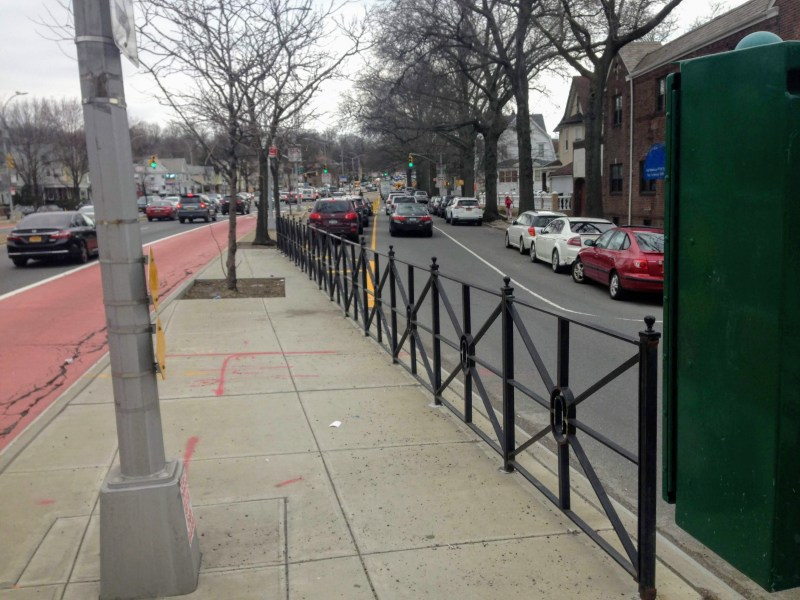Op-Ed: Let’s Build Bus and Bike Infrastructure Together
Each form of transportation reinforces the other.


As the Department of Transportation institutes dedicated bus lanes on various routes — witness the success of the 14th Street busway — safe-streets activists should push further: They should advocate that the department install protected bike lanes along many of the same routes — even (or especially!) if that means sacrificing a car lane or parking.
Bus and bike infrastructure built together can provide more efficient transportation — and more equity for riders — than buses or bicycles alone. The goal should be to erect bike-lane/bus-lane combinations like those of many European cities, for example, like these lanes in Holland.
For example, DOT is installing part-time dedicated bus lanes on Church Avenue in Brooklyn, on Broadway in the Bronx, and on Fresh Pond Road in Queens — in hopes of hastening service on some notoriously slow bus lines. Each of these projects has engendered ferocious pushback from the selfish, car-owning minority in those communities, and DOT and safe-streets advocates have countered with arguments for the lanes citing efficiency (many bus lines are barely faster than walking) and equity (bus commuters are, on average, poorer than even subway commuters).
At the same time, the city is taking steps to overhaul its bus routes, in an effort to make service, faster, more efficient, and pleasanter. And it is building miles of protected bike lanes, as part of its “Green Wave” plan to protect cyclists.

We all know the economic-fairness arguments for promoting faster buses. TransitCenter notes that Bronx bus riders’ average annual incomes ($28,000) lag those even of subway commuters, so better treatment of those commuters makes for a fairer city.

But cycling is a matter of economic fairness, too — even if many city policymakers are under the mistaken impression that it is transportation of choice only of wealthier, younger white residents. Cycling is even cheaper than transit, and more people would cycle if it were safer and more efficient to do so — that is, if we had protected lanes — especially lower-income people living in New York’s many transit deserts.
As New Yorkers are well aware, many lower-income, especially immigrant, residents make their livings delivering food or documents by bike. But many other low-income New Yorkers could benefit from bike lanes along bus routes, too.
Take my family, for example. We are a low-income family living in Eastern Queens, and every day during the school year I escort my younger sister to her school in Ridgewood, Queens. As a student, she gets a fully discounted fare, but I don’t, so that means I pay for transit for 10 months of the year. We can’t bike because it’s just not safe to do so; there are not any protected bike lanes. But using the subways is expensive. We can afford back-to-school supplies in August only because I cycle around the city all summer. The more than $240 we save in July and August goes a long way.
If students like my sister were able to bike to school, New York would save a lot of money and we would save a lot of time. It takes my sister (and me, her escort) 70 minutes (on a good day) to commute 8.5 km (about 5.25 miles) on two buses and a train. But Dutch secondary school students travel similar distances daily in less than a half-hour hour by bicycle. Protected bike lanes that encouraged students to pedal to school also would save the city tens of millions of dollars annually. City students get a half-fare discount on the bus if they live a mile or less from school. Beyond a mile, they get full-fare discounts and subway access. Student travel puts many more riders into the system at peak hours and costs a lot, too.
From this perspective, some of the dedicated bus lanes represent wasted opportunities. For example, Fordham Road in the Bronx got bus lanes a while back, but kept the remaining car lanes — along a congested retail corridor where most people walk to shops and many students would bike to school, if it were safe. Jamaica Avenue in Queens, a major east-west route full of retail, forms the centerpiece of downtown Jamaica, but cyclists have no safe way to bike, park, and spend money and time here.
This is backward! Demote the least efficient mode of transport (car) and promote the more efficient ones (bicycles and buses).

Let’s fix the bus system — but not at the cost of bicycle routes. Buses routes and bike lanes should reinforce each other.
“TransitNinja” blogger Samuel Santaella lives in southeast Queens and volunteers for Riders Alliance and Transportation Alternatives.





